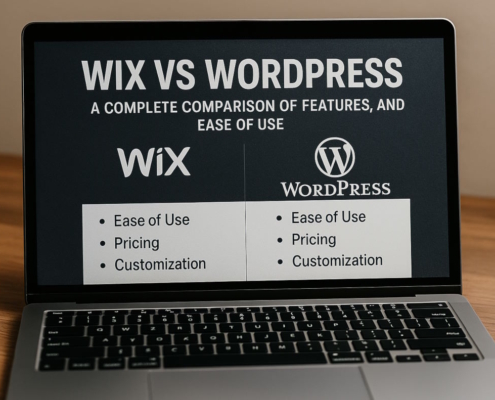What are the steps of starting a business?
If you want to do work that you love, starting a business is a terrific first step. But before you jump in, there are a few important things to think about and questions to ask: What issue are you solving? This applies to anything from coming up with a concept to making a website for your business. Who do you want to reach? How does your service or product stand out from the competition? Above all else, how do you even start?
From coming up with ideas to registering your business and beyond, this all-inclusive article will be your trusted companion along your journey. You can rely on it as an accurate introduction to starting a business, giving you the confidence to navigate the thrilling world of entrepreneurship.
Develop and hone your company concept
Whether you’re still in the early phases of discovering your niche or have a fantastic company concept that you’re eager to launch, there are several perspectives to consider. If you identify with the first group, take stock of your interests and strengths. Building a successful business is no picnic, but when you let your passions and strengths guide you, you’ll have an easier time staying motivated and committed.
You should bear in mind that there are certain serious and inevitable difficulties that small businesses must face. It takes time, creativity, capital, and maybe even financial risk for most company ideas to become profitable. The same holds true for traditional storefronts and virtual ventures. That’s why, initially, you should focus on making your concept better and testing it to see if it works. If you’re stuck for ideas, here are some good ways to start:
Choose a company concept that you’re truly passionate about, but don’t lose sight of the fact that there must be a need in the market for what you’re offering. Is your company concept scalable? Who are you aiming to attract? Is your level of knowledge and experience sufficient?
Put your concept to the test in a real-world setting; this may include anything from a pilot study to a focus group. Another tactic is to create a landing page that may serve as a tool for interest generation and measurement. Try again with a different angle if you can’t get people excited about your concept. Think about how you might revise your concept to make it more marketable or how you can make it more relevant to your target audience’s wants and requirements.
The first step in turning your concept into a profitable business is to develop a workable business plan. This will allow you to scale your venture while keeping costs down. Consider the future of your company: what do you see it like in a year? What about in two years? How about five? Will it last?
Get your business off the ground with these popular ideas:
- Dropshipping: This is a great low-cost way to start a business because it lets you sell things without having to keep track of your own stock. To begin, all you need is a solid marketing plan, an online storefront, or a dedicated dropshipping website.
- Print on demand (POD): POD is another well-liked internet income stream that entails collaborating with vendors that can print your designs on blank products, such mugs and T-shirts, and handle order fulfillment. This is a great method to launch your own online shop while still putting your own touch on retail.
- Freelancing: A portfolio website is a great way for creatives, authors, and artists to showcase their work and attract clients. As an example, consider the work of Berlin-based animator and illustrator Rafael Varona. You can see examples of his work for industry heavyweights like Disney, Porsche, and Google on his sleek and eye-catching Wix website.
- Running a service business: If you want to run a service business, you can sell your knowledge, skills, or help, like when you teach, walk dogs, train people, or plan events.
- Selling things you made yourself: If you’re good at making jewelry, art, home decor, or clothes, you have a great business idea waiting to happen.
- Boring companies: Despite their outward blandness, these companies are everything but. The goods and services offered by these companies are usually necessities, however they might not be very showy. Companies in this sector include those that provide accountancy, insurance, disposal of waste, or manufacturing services.
Is it worthwhile to start a business?
There are a lot of company owners who would answer yes. Owning a business may provide you with a steady income and a sense of purpose in life. In addition, starting a small business can be a great way to break free from the monotony of a 9 to 5 job that might not be fulfilling.
It takes time, energy, and a lot of hard work to launch a viable idea, get financing, and manage a firm, so beginning a business isn’t a walk in the park. Every company has its ups and downs. Make sure you know exactly what you want out of your business and when you want it done before you start it.
How can I put my company concept to the test in an original way without leaving my job?
Consider releasing a weekend-only minimal viable product (MVP) or service to test the waters of your company concept while you maintain your day job (and income). If you want to see if people are interested in your concept, you may check their social media activity or visit a basic company website. Does your website have the ability to attract potential users? After you’ve captured their interest, it’s time to interview or survey prospective clients.
You may launch a little company on the side, during the evenings or on weekends. Although it may be the safest option for starting a business, it requires a lot of time and might require you to keep your day job.
Perform research on the market and your competitors
Conducting market research is essential when your company is just starting out. You may better cater your products or services to your target audience if you take the time to learn about their wants and requirements at this stage. You may also use it to assess the state of the competition, spot unfilled niches in the market, and make calculated choices. When you do all of this, you improve your odds of success and decrease your risk.
There are two main types of studies that examine consumer behavior: primary and secondary.
Primary research involves studying your target market directly through methods like focus groups and user interviews. It’s important to identify your target audience and then divide them into subsets based on factors like age, geography, language, disposable income, and life stage (e.g., recent graduates, new spouses, and retirees).
The term “secondary research” describes the process of acquiring data from non-original sources. Look up information on the internet or consult any government website, such as the U.S. Bureau of Labor Statistics. Eventually, you may also discover that internal data is equally valuable. See for yourself which trends were a smashing success by consulting your own sales data.
By combining primary and secondary sources, you can build a comprehensive SWOT analysis. This will help you assess and analyze your company’s overall outlook in comparison to your rivals. Start by making a four-quadrant table. In each quadrant, list the advantages, disadvantages, opportunities, and dangers that your company faces.
- Advantages: Think about what makes your company special. The next step is to identify your rivals and then ask yourself, “How can I outdo them?” Take a look at their offerings to get a feel for what draws in clients; then, utilize that knowledge to inform how you position your own company and what sets you apart from the competition.
- Downsides: Be truthful with yourself on this one. Give me your honest opinion on what consumers find annoying or unsatisfactory. By doing so, you may focus on a single issue at a time, rather than trying to answer a broad question like, “What is my company doing wrong?””
- Opportunities: Consider the future of your company from a growth perspective. Think of seasonal events, a green project, or trying out trends as potential strategies to grow and enter new markets.
- Risks: Watch out for anything outside your control that can have a negative impact on your company. It might be anything from changes in the market to customers who suddenly lose interest in what you have to offer.
Keep in mind that you should play to what you know your audience wants. If you want to establish a business, you need to do market research to find a need in the market or come up with a way to improve an existing product.
Create a company identity
Are you happy with your company concept? The following thing to do is to think of a name for your company that will attract customers.
You should aim for a name that is both memorable and scalable, meaning it can accommodate future growth in terms of geographic reach, product lines, or specializations.
Your preferred company name may already be in use, so it’s a good idea to verify whether it is available. To find a trademark, you can use either the Trademark Electronic Search System or the website of the state’s secretary of state. In the long run, you should consider creating a website for your company. Check the availability of your preferred name via a domain name search; this is especially important if you intend for it to serve as the name of your company.
Develop a company strategy
Developing a well-structured strategy is another critical component in launching a company. A business plan, at its most basic, is a document outlining the proposed framework, operations, and management of your new enterprise. There are a number of uses for it, including attracting investors, gaining banks’ confidence, and calculating how much it will cost to launch your firm. To put your ideas down on paper, you could use a business plan template.
Your business strategy, regardless of your starting point, needs to contain the following:
- Executive summary: This is a short description of your business idea or plan. This is the kind of thing you would say out loud if you were doing a professional elevator pitch (a brief overview of your company).
- Company description: List the name of your business, the names of the people who started it, where it’s located, and what its purpose is. In your mission statement, you should outline your fundamental principles, long-term objectives, and promise to deliver high-quality goods and services to your customers.
- Market research: Talk about things like small business growth and trends in your field. Consider the scope and predicted development of your industry as you compose this section. Keep an eye on your rivals and make mental notes of their advantages and disadvantages.
- Customer analysis: Describe the people you want to reach and how you plan to do it. Make sure your product or service is meeting your clients’ demands by outlining them in detail.
- Leadership and organizational structure: Outline the structure and leadership of your company, including its founders, executives, board members, employees, and key stakeholders. If you want to show your company’s structure in the best light possible, consider using an organizational chart or other visual depiction.
- Services and products: Compile a catalogue of all the goods and services you provide, both current and planned. Create a concept statement outlining your goals and objectives if you haven’t yet settled on a concrete company plan. To further demonstrate the practicality of your proposal, you should provide a proof of concept (POC).
- Sales and marketing: Describe the process by which your company idea generates revenue. Describe your marketing approach, including what you want to do in terms of promotions, advertisements, pricing, channels of distribution, digital marketing, and the many points of contact with consumers (website, smartphone app, retail shop, etc.).
- Revenue projections: Give an idea of how much money you expect to make, or offer some numbers on early sales. To back up their risk, investors require concrete data. It is important to include a sales forecast that takes industry and market trends into consideration, as well as expenses, overhead costs, sunk costs, the point at which you plan to break even, cash flow, accounts receivable, and projected profits or losses.
- Strategic plan: Conclude with a course of action. Make sure everyone on your team knows their specific SMART goal and how they can help reach it. If someone asks, “Is there a timeline?” and “What are the goals you want to achieve?”, have answers ready. In both cases, think about years and quarters.
Decide on a business structure
A number of considerations, including your desired level of personal accountability, tax implications, and whether you need to register your firm, will dictate the type of legal structure that is most suited to your needs. Sole proprietorships, for instance, are the simplest to form but expose their owners to the greatest amount of personal responsibility. You may shield yourself from many personal obligations by forming an LLC, but be prepared to pay a high tax bill.
Looking at your choices as listed by the U.S. Small Business Administration is a great place to start. In the United States, the most prevalent forms of company or company entity are:
A sole proprietorship: A company that is owned by only one person, who also bears all of its legal obligations. The proprietor is personally responsible for any obligations or legal matters that may develop, which can expose private assets to danger, and the proprietor’s personal income tax return details the company’s gains and losses.
In a partnership, two or more parties divide up the assets, liabilities, and management of the business. Profits and losses “flow through” to the partners, who then record them on their individual tax returns, rather than the partnership itself paying income tax. There is a possibility that partners’ private assets may be at risk due to the fact that they are individually liable for the partnership’s debts and liabilities.
A corporation is a type of legal entity that has its own identity apart from its owners (shareholders). It has the power to engage in business activities and incur obligations independently. While shareholders of a corporation do not often face individual accountability for the company’s commitments and debts, they do face corporate income tax on the profits of the corporation.
Dividends paid out by corporations to their shareholders are subject to individual income taxation. Particularly notable are C-corps and S-corps, two forms of corporations that have distinct legal consequences.
The restricted liability protection of a corporation and the flexibility of a partnership are both offered by limited liability companies (LLCs). The tax treatment of an LLC can be either that of a corporation or that of a pass-through organization, depending on the owners’ preference.
What factors should you consider before making your decision? LegalZoom’s Vice President and Associate General Counsel, Shylene D’Addario, offers some sage advice:
In terms of company structures, the most common ones according to the IRS are sole proprietorships, partnerships, corporations, and limited liability companies (LLCs). But which one is right for you, and why?
If you’re just starting up and don’t have any big contracts with vendors, subcontractors, or workers, a sole proprietorship may be the way to go.
To avoid being held personally liable for their partners’ carelessness, misconduct, or internal disputes, general partners in a business with two or more owners that hasn’t formed an entity usually divide up the management responsibilities and share in the profits and losses.
Because of the limited liability and flexibility that they offer, limited liability companies (LLCs) are a popular choice among small business owners for protection from personal responsibility for business debts and obligations in the event that the LLC is unable to pay its debts or fulfill its obligations.
The owners (the “shareholders”) of a corporation enjoy the same protections against legal action as those of an LLC. However, depending on the state in which you form your corporation, you may be subject to more stringent recordkeeping and reporting obligations.
Find the best business structure for your needs by doing your homework and weighing the pros and cons of each option. A business lawyer may offer advice on this, and the IRS’s guide to business structures can help you evaluate the tax consequences.
How is beginning a small business different from starting an enterprise?
While there are some commonalities between launching a small firm and an enterprise, the two are substantially different in terms of scale, scope, and objectives.
Similar to how a small, independent toy store in a town differs from a massive brand like Toys R Us in terms of size, small businesses tend to be more focused on serving a local or niche market with a small number of employees. On the other hand, enterprises tend to be larger in scale and have a broader geographic reach.
In contrast to the more straightforward ownership models seen in smaller businesses, where the owner is heavily involved in running the day-to-day operations, the ownership structure of larger enterprises is typically more convoluted, with multiple owners, shareholders, and a board of directors. This can lead to a decrease in the owner’s level of involvement in the daily affairs of the company.
Enterprises often seek to gain a greater share of the market or diversify their offerings, while small businesses typically provide a narrow range of products or services tailored to a specific customer base. Personal, local solutions may be the focus of small businesses.
Although small businesses can experience growth over time, their main focus may be on maintaining a steady income or lifestyle. On the other hand, enterprises typically aim for rapid growth and scaling, which involves expanding their operations, competitive edge, and revenue generation.
Acquire funds and cash for your business
A recent survey found that 47% of startups fail due to a lack of financing, with running out of cash coming in second (44%). It’s important to start thinking about finances early on because you’ll need enough capital and a steady flow of cash to launch your business.
There is a wide variety of approaches of generating money for a business. Some examples include submitting an application for a loan or grant, contacting an angel investor, or organizing a fundraising event.
You can keep more control over your business and its direction by bootstrapping, which means you’re using your own money to finance it. However, you run the risk of taking on personal debt and may not see as much return on investment as you would with an outside investor.
There are a lot of crowdfunding sites out there; while deciding which one to use, it’s important to weigh the fees, terms and conditions, and audience type of each. Crowdfunding is a quick and easy method to share your ideas with a large audience, gain feedback, and collect money all at once.
The main perk of getting grants is that you don’t have to pay them back. If you’re looking for grants and want to know if you qualify, you can start on the grants for community organizations page of the US Small Business Administration website. Then there are private organizations like the Second Service Foundation and FedEx that offer grants for small businesses.
When used responsibly, credit cards can be a great way to fund a new business. To maximize your rewards, look for a business credit card with a 0% introductory APR period and a rewards structure that lets you earn cash back, credit statements, or miles. Making payments on time and keeping your usage of credit below 30% will help build your business credit score, which is important for getting different kinds of financing.
In order to apply for a startup business loan, small businesses can use the faq services offered by banks and other financial institutions. The first step is to determine how much money you need and why. You can use the financial projections in your business plan to get a ballpark figure, and then you can figure out what kind of loan you need.
Borrowing and repaying money from a business line of credit (LOC) is as easy as using a credit card. While most LOCs have an annual income and length of business requirement, new business owners with good personal credit (over 670) and collateral may be eligible to apply.
A large number of active high-net-worth individuals, known as angel investors, use their personal funds to seed startups, especially in the early stages. Some examples of angel investing firms that provide venture capital funding include Tech Coast Angels in Los Angeles and Golden Seeds LLC in New York City.
But beyond the usual suspects like bank loans and venture capital, what are other creative methods to raise money?
The following are some of the many methods that are available: revenue-based financing, blockchain-based token offerings, peer-to-peer lending, startup accelerators with funding, angel investor syndicates, grants, competitions, royalty financing, customers as investors, invoice financing, and micro-loan programs. Some of these methods are more established than others, whereas some are particularly innovative.
Get your business registered and official
You must finish all the necessary formalities and legal documents before you launch your company. In the United States, the procedures for registering a business name are location and structure-dependent.
If you want your entrepreneurial venture to succeed and grow, you should register it with the Small Business Administration (SBA) so you may enjoy personal liability protection, legal and trademark protection, and tax benefits, among other advantages.
Meanwhile, everyone planning to launch a company in the European Union or the United Kingdom must study up on the many regulations and standards governing company registration, applicable certificates, and value-added tax.
File for necessary licenses, permits, and tax IDs
If you want to start a business in the United States, one thing you’ll need is a federal and state tax ID, also called an employer identification number (EIN). This will allow the government to track your company and collect taxes at the federal and state levels. With a tax ID number, you can also open a bank account, apply for licenses and permits, and hire staff members.
If your company’s operations are subject to federal regulation, such as selling drinks with alcohol or communicating on public radio, you will be required to obtain a license. To learn more about this, you can visit your local government’s website. You can also consult the Small Business Administration’s list of business requirements for federal licenses and permits.
The IRS’s EIN Assistant tool makes it easy to apply for an EIN online for free. However, tax requirements differ from state to state, so it’s important to check your state’s website to see if you need a state tax ID number to stay in compliance. Additionally, you’ll need to know which IRS forms are applicable to your business, income statement, tax return process, income tax audit process, and corporate tax payments, if applicable.
Small business owners may be required to pay a variety of taxes depending on their location, industry, and business activities, says Sabrina Papini, marketing director of eCommerce and marketplaces at Avalara. Among these taxes, business owners may have to pay:
- Sales tax: The rate and rules may differ depending on the region and the kind of products or services supplied, but if your company sells to consumers in a certain jurisdiction, you may be required to collect and remit sales tax.
- Local and state taxes: In addition to sales tax, your company may be subject to other local and state taxes, such as property taxes, business privilege taxes, fees for obtaining a business license, and taxes that are particular to your city.
- Excise tax: The producer, importer, or distributor of a regulated article may be required by law to pay a tax on certain items, such as alcoholic beverages, tobacco, gasoline, or other similar controlled items.
- International taxes: If the company does business on a global scale, it may be subject to a variety of international taxes and fees, such as value-added tax (VAT), goods and services tax (GST), customs duties, or tariffs. It is important to be aware of any potential double taxation liabilities if you are a U.S. business operating overseas or a foreign business operating from the U.S.
According to Papini, tax planning should start at the beginning of the process. To stay compliant with rules and manage taxes, it is vital to use automated systems, stay updated about tax changes, and seek expert help when needed. In addition to preventing legal trouble, these measures will help your company thrive.
Get a company insurance policy
If you’re just starting out as a small business owner, getting insurance is a must. It will protect your startup from any financial liabilities and protect your assets from accidents. With business insurance, you can rest assured that your company will be able to weather any storm.
First things first when applying for insurance: take stock of the company you run and all the potential hazards it faces. This includes things like possible dangers, liabilities associated with your products or services, and lawsuits. Then, think about the coverage types that suit your business best, like general liability, professional liability, casualty, property, etc.
There are many different kinds of insurance, and a good insurance broker can help you go through them all to identify the policy that best suits your needs in terms of price and coverage.
In the event that an employee sustains an injury or sickness while on the job, workers’ compensation insurance will pay for their medical bills and missed income. This policy is required by law in the majority of states.
In the event that an accident occurs on the company’s premises or as a consequence of your products or services, general liability insurance will cover any medical bills, lost wages, or property damage that any third party may suffer as a result.
Professional liability insurance, sometimes called “errors and omissions insurance,” safeguards policyholders from allegations of carelessness, mistakes, or omissions while rendering expert advice or services.
Businesses should have property insurance to safeguard their facilities, equipment, inventory, and furnishings against perils like theft, fire, and severe weather.
Product liability insurance protects your company from lawsuits filed by customers who allege that your faulty goods caused them bodily harm or property damage.
Business interruption insurance will pay for your lost income and ongoing costs if your business can’t run because of an insured event, like a fire or natural disaster.
Employment practices liability insurance, or EPLI, covers claims about unfair labor practices like firing someone without cause, discrimination, or misconduct.
Get your money in order
When you’re getting your company systems in place, it’s a good idea to set up a business bank account and think about how you’ll handle your accounting. Having organized and precise financials is crucial to keeping a company running efficiently.
Open a checking account for your company
Most importantly, it is essential to keep your personal and business finances completely separate in order to maintain accurate and organized records. A separate business bank account allows you to track your income, expenses, and profits more effectively, which simplifies tax preparation and accounting tasks.
In addition, most business loans and lines of credit require you to have a business bank account. Having one also shows that you take your business seriously, which is good for your reputation among clients, colleagues, and possible investors.
In most cases, you’ll need to provide specific documents in order to open a business bank account. If you’re unsure whether a bank can handle your business’s needs, it’s a good idea to ask them about account fees, transaction limits, credit possibilities, and integration with financial accounting software. You should also make sure to provide your business registration paperwork and your employer identification number (EIN) or Social Security number (SSN).
Get your books in order
If you want your business to succeed, you need an organized system for keeping track of money. There are a lot of accounting apps and software out there that can help you with this, or you can hire a certified public accountant (CPA) to handle it. Make sure your system is thorough and accurate when it comes to paying taxes, managing invoices, and payroll.
Establish a brand for your company
Developing a brand is an essential aspect of learning how to launch a small business and mold a corporate image. To put it simply, branding is the process of giving your company a distinct personality, story, values, and visual identity through the creation of a logo, brand colors, and other visual elements.
1. Visuals of the brand
To generate a consistent visual identity for your company, you need to make sure to include the following components in your brand visuals:
- Logo: A logo is the first impression customers will have of your company. A good logo should be adaptable, catchy, and simple to recognize.
- Color scheme: Pick a group of main and accent colors that represent your brand’s character and make people feel the way you want them to.
- Typography: Choose legible typefaces that match the style of your brand and work well in many formats.
- Visuals: Consider photography, drawings, or graphics when deciding what kinds of visuals will best convey your brand’s message.
- Iconography: Make your own unique set of symbols or icons and utilize them consistently in all of your branding materials.
- Website design: When creating your site’s layout, banners, buttons, and other visual elements, make sure to incorporate your brand’s colors and images.
- Think about how your brand’s images will look on paper in things like brochures, packaging, and business cards.
- Email: It only takes a few steps to make a business email. Make branded themes to keep your online interactions consistent.
- Building an emotional connection with consumers is easier with a clearly articulated brand narrative that addresses your:
- Background: Tell the tale of your brand’s creation, from the inspirations and obstacles that prompted its launch, as well as the reasons behind its creation.
- Personal path of the founder: If relevant, add a personal touch to the brand by discussing the founder’s background and how it relates to the business.
- Brand purpose: Make it clear why your brand exists, what its main goal is, and what problem it wants to solve for its clientele.
- Brand values: Identify the core beliefs and ideals that guide your brand’s actions and decisions.
- Evolution: Talk about how your business has changed over time and show that you’re dedicated to always getting better.
2. A company’s brand voice
Brand voice sets a steady tone that shows who you are and how you talk to people. It also helps customers connect with the person behind the business, which directly translates into sales.
If you want people to remember your brand, your voice has to be consistent across all platforms. Here are a few things to keep in mind:
- Persona: Think about the kind of impression you want to leave on your intended readers, and then develop a voice that fits that description.
- Language: Speak in a way that reflects your chosen persona, whether it’s authoritative, informed, approachable, or funny.
- Plan your communication: Be clear about how you’ll answer customer questions, notes, emails, reviews, and calls.
Design an expert company website
Having a well-designed and functional website is crucial for any new business. It serves as an initial point of contact for potential clients, investors, and business associates, and it’s a chance to make a good impression.
Make your company’s website search engine optimized
Search engine optimization (SEO) is a must-know for anyone starting an online business. It’s all about getting your web content optimized to rank higher in search results for specific keywords. As Rebecca Tomasis, an SEO expert for Wix Blogs, puts it, the more keywords you employ, the higher you rank in the internet search. These hits convert to actual sales.
If you run an online store selling organic baby goods, for instance, you want to be sure that your content includes specific keywords like “eco baby products” and “natural baby toys” so that it shows up in search results when people use such terms.
If you’re looking for phrases to include in your site content, you may utilize keyword research tools like Google Keyword Planner, Ahrefs, or Semrush.
Your website should be responsive, load quickly (even on mobile), and be straightforward for search engines to crawl. There should be no dead links, duplicate content, or large, slow-loading media files that can affect the experience of users.
When optimizing your website for search engines, it is important to focus on optimizing individual pages for the keywords you have chosen. One way to do this is by organically including your core keyword into the page’s title, headers, meta description, and content.
Write useful, interesting, and informative posts that meet the needs of your readers. If you run a blog, well-written posts will bring people to it and make them stay longer, which tells search engines that the post is relevant. Ensure that your content provides value and answers the question behind the keyword being searched as simply and as effectively as possible, says Tomasis. Everything about the article—its structure, its headings, and its data—should be tailored to meet the intent of the user searching.
With more and more people accessing the internet through mobile devices, it is essential to optimize your website for mobile devices in order to improve search engine optimization (SEO) and user experience (UX).
If your company caters to a local clientele, you should focus on local search engine optimization. This includes things like claiming and optimizing your Google My Business page, making sure your NAP (name, address, phone number) is consistent across all of your online properties, and promoting customer reviews.
Get the word out about your company
In order to take your small business to the next level, you need a solid marketing strategy. According to Erin Shea, Senior Director of North America Marketing for VistaPrint, consumers are the foundation of any profitable small business and successful advertising is one of the best ways to establish and maintain your community. So, after you’ve introduced your business and released your website, you can start building your marketing plan.
Some of the most typical advertising approaches are as follows:
- Paid advertising: With targeted ads, small businesses can reach a huge audience of people looking for what they offer. Google Ads are very popular because they allow businesses to bid on relevant keywords, which makes sure their ads show up prominently in search engine results.
- Marketing on social media: Advertising on social media exposes your business to a wide audience. Find the platform where your target demographic spends time and be active there. Paid social media marketing is another option.
- Email marketing: Email marketing is a highly effective tactic that can promote your brand and build engagement. It allows you to reach customers directly, build a loyalty program, and customize messages based on their individual interests.
- Content marketing: Creating and sharing useful and interesting content to attract your target audience. You can do this in a number of ways, such as by starting a blog, a podcast, or a YouTube channel. Use any of these to notify people about changes in your company, share news about your field, and interact with your prospective clients.
A low-cost method that may generate organic growth for businesses is word of mouth, which, when done well, can improve your brand’s image and credibility, which in turn increases customer loyalty and new customer acquisition.
Whether you’re engaging clients online or offline, remember that consistency is worth its weight in gold. Finding the correct marketing plan may take some time, testing, and patience. However, as Erin points out, consistency is crucial. Try out several forms of advertising to find what works, even if you’re just starting out. You should allocate a larger percentage of your income for marketing as your sales increase, and you should keep building.
Put together a team
You may find it challenging to juggle various responsibilities as your business expands; this is where staffing up and assigning responsibilities comes into play. Freelancers and independent contractors might be useful if you don’t want to employ full-time employees.
Always keep your requirements, budget, and desired corporate culture in mind while making employment decisions. To find the appropriate individuals to meet all of these needs, you need draft a clear vision statement.
When building a team, there are several efficient methods to find new members. Some suggestions to kick things off:
- Online job boards: Sites such as Indeed, LinkedIn, and Glassdoor allow users to post job openings and discover qualified candidates.
- Local job boards: A lot of towns and cities have local job boards or sites where companies can post employment opportunities to get local applicants.
- College career centers: Get in touch with the career centers at nearby colleges and universities to meet bright students or recent graduates who are looking for work.
- Networking events: Meet prospective employees face to face at job fairs or industry-specific business networking events to talk about open positions.
- Social media: To attract job searchers and reach a wider audience, use social media platforms such as Instagram, Facebook, and X (previously Twitter).
- Platforms for freelancers: Sites like Fiverr, Freelancer, and Upwork connect clients with independent contractors who can complete unique tasks or offer niche expertise.
- Groups or forums that are specific to an industry: Join online forums or social media groups that are specific to a profession to find skilled workers looking for jobs in that industry.
What are the most difficult aspects of starting a business?
Here are seven obstacles that new company owners often encounter; take a minute to think about how you might overcome them.
- Being a business owner is hard when you have to run everything by yourself.
When they first launch their company, entrepreneurs typically juggle a lot of tasks, including sales, accounting, marketing, IT, and more. But they probably aren’t perfect at everything, and that might lead to stress. At first, The Ecommerce Accountants’ founder, Chris Rivera, believed that all it took to run a profitable accounting practice was to be a competent accountant. But they needed to learn more than just accounting, especially sales and marketing, since they discovered very fast that their technical knowledge wasn’t going to cut it.
Rivera had to figure out how to promote the firm, draw in customers, and explain its worth. What Rivera didn’t expect as an accountant was the amount of time and effort they would need to put into studying sales techniques.
But no matter how many skills you acquire, you will never be able to do it all by yourself. You endanger not just your professional success but also your physical and emotional well-being if you try to pull this off.
How to conquer the difficulties of operating the business by yourself
Recognize the value of your time and be forthright about your limitations when operating a business. Sharing the burden is vital, even though you can and should welcome professional growth and learn more, like Rivera did.
For all the things that go into managing a company, here are a few pointers:
Ask for assistance: Although it may be difficult to let go of control, Rivera thinks that a strong team is crucial to an entrepreneur’s success. The shift from working independently to leading and expanding a team had its fair share of challenges, as Rivera candidly said. Giving up some control is still worth it if it means your firm grows and succeeds. Some options to help alleviate the workload include working with a digital marketing firm, finding an IT partner, or hiring a virtual assistant.
Make use of tools provided by the Small Business Association: Look into the Small Business Development Centers Office of the Small Business Association (SBA). With specialists available in regional offices around the country, this SBA program serves as a one-stop shop for potential and existing small company owners. You will gain insight into many areas of managing a company.
Streamline your operations: Get your company in order to avoid feeling overwhelmed. Your daily duties and objectives should be defined and written down. Make a priority and cluster-related to-do list when you’ve compiled all of your to-dos. When you choose priorities, you can see which objectives and chores to do first, so you can make the most of your time. By grouping related activities into smaller, more manageable chunks, you can get more done in less time.
- One of the hardest parts of starting a business is getting money.
One of the most difficult things for new company owners to do is to find investors and other sources of funding. Not every company need a large sum of money quickly. However, you need to be sure you can sustain the company over the long haul.
Solutions to problems with financing
You can either seek a line of credit, apply for a business loan, self-fund, or raise funds when you establish a company.
Some tried-and-true methods for navigating the obstacles of raising capital are as follows:
Make use of SCORE’s resources: SCORE is a resource partner of the SBA that provides small companies with mentors, education, and advisers. For guidance from experienced businesspeople on how to secure capital for your company, check out the SCORE website.
- Have a look at microloans: New company owners also have the option of applying for microloans, which are usually for amounts below $50,000. Microloans are more accessible because of their smaller size. Plus, you may take advantage of financing options that you would not have had access to before. Microloans are a great source of operating cash, startup funding, or for other startup-related needs. You may also use the money for things like additional employees, office space, or equipment. The eligibility criteria (such a minimum credit score) and restrictions on the use of the money are variable between microlenders.
- Borrow money from the Small Business Administration (SBA): If you’re an entrepreneur looking to launch or grow your company. (To find out more about the SBA’s microloan program, you can get in touch with your neighborhood office.)
- Get your investor pitch ready: Make sure your pitch is great before you show investors your company plan. Financial institutions, including banks and investors, will want to know how you plan to achieve your goals. Your chances of securing the necessary financing are directly proportional to how well you can express this concept.
- A startup has the issue of finding and attracting consumers.
Many new businesses fail miserably when it comes to attracting clients. After all, there’s no use in trying to sell anything if nobody buys it. In an ideal world, you would check if there is an interested market before starting your firm. Finding out who you’re selling to, what they need, and how much they’re prepared to spend is the next step.
Strategies for overcoming the difficulty of getting clients
In order to locate and entice clients, you need to develop a marketing strategy that details:
- Your target market
- The advantages and disadvantages of your product in relation to similar offerings from other companies
- Your message and marketing stance
- The place where you want to advertise your wares
- Spending on advertising
Strategies that don’t break the bank but nevertheless have a significant influence are crucial for startups with limited budgets for advertising. Marketers that are short on funds could think about things like:
- Developing advertising strategies for social media users
- Developing partnerships with businesses that offer related goods for the purpose of joint marketing
- Creating email marketing programs
- Making use of video marketing to build confidence in the brand
- Organizing programs or events that will be covered by the media
- When you’re first starting out, it might be tough to keep a work-life balance.
The difficulties of striking a healthy work-life balance are something every successful entrepreneur can attest to. There’s a good chance you’ll spend every waking moment glued to your screen, from the moment you wake up until you eat dinner, and then a couple more hours at night checking things off your list. All of a sudden, you might be so preoccupied with work and business that you forget about the importance of things like getting enough sleep, exercising, and spending time with loved ones.
Methods for resolving conflicts related to work-life balance
No matter how challenging it may be, it is essential to develop a pattern that clearly separates work time from leisure or family time. We all have our own unique ways of getting things done. Although, if writing down “run a mile at noon” on your calendar helps you keep the pledge, then do it.
Do not jump into tomorrow’s responsibilities if you finish everything on your to-do list by 8 p.m. Instead, spend that additional time with your family or think about getting to bed early. Do this for the benefit of your mind and body.
- It might be difficult for businesses to operate without a safety net.
Despite the difficulties, having a regular income is one of the many advantages of working a full-time job. For instance, having health insurance and other advantages offered by your job (such as retirement plans and guaranteed pensions) might help you relax.
You will not have the security nets of a regular paycheck when you go out on your own. Paid in full or in part, you are subject to payroll taxes, and your income is not secure until the company begins to generate sufficient profits. You will have to go into the company’s funds to set up health insurance or benefits.
What to do when there is no safety net
It could be scary to not have any kind of financial cushion. But there are a number of ways you can lessen the strain:
Start your business on the side while you keep your day job to ensure financial stability. This way, you may work while your business grows. Long hours and effort are necessary for this option. Once your business is up and running, though, you’ll value the regular paycheck and other perks.
Angel investors, business loans, and grants are other options for getting a comfortable sum of money to start a company. You may pay yourself a modest wage while you run and expand your business if you have enough money.
Keep starting expenses to a minimum: Depending on your line of work, you can do your best to keep initial expenses to a minimum while still relying on personal savings and other assets to sustain yourself.
- New company owners may find accountability to be a major obstacle.
Keeping track of due dates, projects, and performance objectives is an important part of every job. Having said that, when you’re your own boss, the pressure to succeed is constant. You need a strong work ethic and the ability to inspire yourself to get things done. When things don’t work out as planned, nobody else can be held responsible.
The problem of responsibility and how to solve it
It is a tenet of most entrepreneurs that they are ultimately responsible for their actions. But they need to get their priorities straight and learn to manage their time well if they want to succeed.
Think about the following to help you prioritize your work:
- Find a digital calendar, application, or platform that can help you organize your projects and set reminders
- Make a checklist of to-dos, and put the most important things at the top
- Set a due date and your best guess for how long it will take to do each assignment
Maintaining a consistent work schedule requires constant management and supervision. You can learn and improve your time management skills. Here are some ideas to think about:
- Learn how to better manage your time by enrolling in a class.
- Pick a strategy for managing your time, such as block scheduling. Focusing on a single activity for a set amount of time allows you to get more done (for example, maybe you read and reply to emails from 8:30 to 9 in the morning and make customer service calls from 9 to 10 in the morning).
- Prioritize your work and do it when you are at your most efficient and focused.
- Cut down on mindless activities like checking your feeds on social media.
- To save time, think about getting an independent contractor to help you out.
- It’s not always easy to hire and fire people
Startups can’t make it without the right staff on board; to spread the workload, business owners often recruit a mix of full- and part-timers. The employees at a startup usually have to wear many hats. So, business owners seek out people with a wide range of skills who can adapt to their needs and help with both development and operations.
But it’s easier said than done to assemble a strong team. One of the most challenging aspects of running a company, according to Thayer Sylvester, co-founder and CEO of Carve Designs, is recruitment. Businesses often have to contemplate firing employees who were promising on paper before committing further resources to them because they just aren’t a good match.
Methods for resolving problems with recruiting and firing
Selection processes are inherently imperfect. Nonetheless, new businesses may take steps to increase the likelihood that they will hire people who share their values and goals. Think on these hiring pointers:
- In addition to outlining the duties of the position, your job description should be quite detailed on the ideal candidate you are hoping to attract.
- Highlight the significance of recruiting for a cultural fit and the company’s culture during the interview process.
- You should go over the position’s required hard and soft abilities.
- Offering stock options or profit sharing might be a good alternative to a significant pay package in a competitive employment market when funds are limited.
However meticulous and considerate your hiring process is, not every new hire will be a good fit. When you realize an employee isn’t a good fit, Sylvester says to break ties quickly. Mistakes happen, and we can’t always hire the right person. It is vital to the organization’s success to learn to detect that immediately and have open discourse around why a given individual is not the perfect match. Then, moving on and recruiting the right individual.
Keep your cool, express your gratitude for their efforts, and then lay out the reasoning behind your decision. Firing an employee is never easy, but it’s necessary.






























